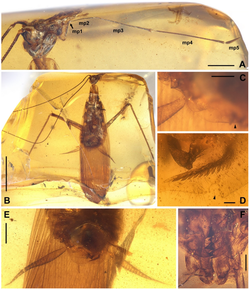Biology:Manipulator (insect)
| Manipulator | |
|---|---|

| |
| Fossil specimen | |
| Scientific classification | |
| Domain: | Eukaryota |
| Kingdom: | Animalia |
| Phylum: | Arthropoda |
| Class: | Insecta |
| Order: | Blattodea |
| Superfamily: | Corydioidea |
| Family: | †Manipulatoridae Vršanský & Bechly 2015[1] |
| Genus: | †Manipulator Vršanský & Bechly 2015[1] |
| Species: | †M. modificaputis
|
| Binomial name | |
| †Manipulator modificaputis Vršanský & Bechly 2015[1]
| |
Manipulator modificaputis is an extinct cockroach which lived during the Upper Cretaceous period. The holotype specimen is fossilized in a 100-million-year-old piece of Burmese amber, which was found in a quarry of volcanoclastic mudstone (a sedimentary rock) at Noije Bum in the Hukawng Valley in Myanmar. The insect was described by Peter Vršanský, of the Geological Institute SAS of Bratislava, and by Günter Bechly, of the Staatliches Museum für Naturkunde in Stuttgart.[1]
The cockroach was found to have an elongated neck, a freely rotating head and unexpectedly long legs, which are indicative of a predatory lifestyle.[2] However, as of 2022, it is thought that M. modificaputis tended to live around and feed on flowers.[3] In addition, this insect has some characteristics superficially similar to mantises, however differ from other many characters.[3] The insect body is 9.3 millimetres (0.37 in) long with 14.7 millimetres (0.58 in) long forewings for male and 10.9 millimetres (0.43 in) body length, 13.4 millimetres (0.53 in) forewing length for female.[3]
The authors erected a new family, Manipulatoridae, after examining the specimen on the basis of "the unique habitus with numerous autapomorphies along with several plesiomorphies."[4] Other specimens including that of a juvenile were discovered from the Myanmar amber mines[4] and described in 2022.[3]
This species was found along with dozens of other extinct species of insects fully preserved in amber, making Noije Bum in the Hukawng Valley region one of the most important regions for amber fossils containing fully preserved insects.[5]
This species belonged to the invertebrate fauna of the ancient amber forest of the Myanmar region.[1]
It was the only member of the family Manipulatoridae until 2022, when the related genus Manipulatoides was described from the same deposit.[3]
References
- ↑ 1.0 1.1 1.2 1.3 1.4 Vrsanský, Peter; Bechly, Günter (2015-04-01). "New predatory cockroaches (Insecta: Blattaria: Manipulatoridae fam.n.) from the Upper Cretaceous Myanmar amber". Geologica Carpathica 66 (2): 133–138. doi:10.1515/geoca-2015-0015. ISSN 1335-0552. Bibcode: 2015GCarp..66..133V. http://www.geologicacarpathica.com/browse-journal/volumes/66-2/article-760/.
- ↑ Mico Tatalovic (1 May 2015). "Predatory cockroach from dinosaur era found trapped in amber". New Scientist Life. https://www.newscientist.com/article/dn27439-predatory-cockroach-from-dinosaur-era-found-trapped-in-amber.html#.VUfPZNKqqko. Retrieved 5 May 2015.
- ↑ 3.0 3.1 3.2 3.3 3.4 Li, Xinran; Huang, Diying (2022). "Predators or Herbivores: Cockroaches of Manipulatoridae Revisited with a New Genus from Cretaceous Myanmar Amber (Dictyoptera: Blattaria: Corydioidea)" (in en). Insects 13 (8): 732. doi:10.3390/insects13080732. ISSN 2075-4450. PMID 36005357.
- ↑ 4.0 4.1 Owano, nancy (1 May 2015). "Dinosaur-times cockroach caught in amber, from Myanmar". http://phys.org/news/2015-05-dinosaur-times-cockroach-caught-amber-myanmar.html. Retrieved 5 May 2015.
- ↑ Hooton, Christopher (1 May 2015). "100 million-year-old insect discovered perfectly preserved". The Independent. https://www.independent.co.uk/news/science/100-millionyearold-insect-discovered-perfectly-preserved-10218634.html. Retrieved 5 May 2015.
Wikidata ☰ Q19845485 entry
 |

